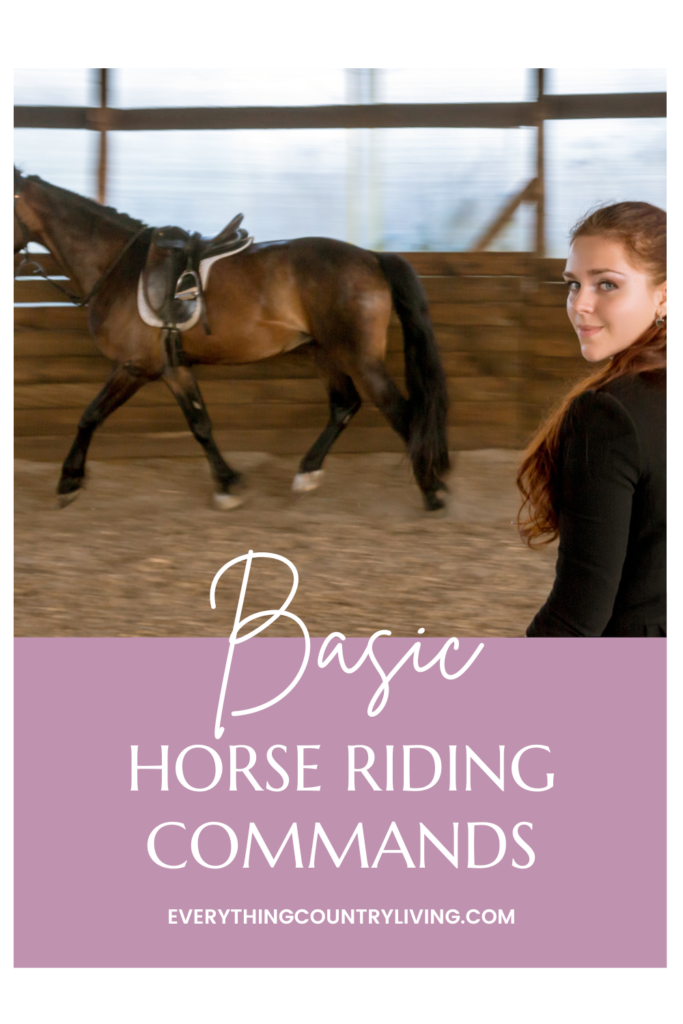
This article is about using your voice for basic horse riding commands.

Using your voice to tell a horse what to do is an important part of training. Even if your horse already knows some commands, it’s good to practice the basic horse riding commands to see how well they understand and if they need more training.
Horses are highly responsive to sounds. This is helpful when teaching your horse basic horse riding commands using your voice. Make sure to speak with authority, enunciate your words clearly, and use high or low intonations (pitch). When you want your horse to go at a faster gait/speed, raise your voice at the end of your command and when you want your horse to slow down, lower your voice. It is important when communicating with your horse using your voice to be assertive and capture his attention.
To make sure your horse listens to your voice, begin by teaching them while you’re on the ground. For example, when you’re guiding a young horse or doing other training on the ground. Once they get the hang of it, slowly start using these commands when you’re riding.
It’s much easier for both you and your horse if you teach these commands little by little instead of all at once. This way, you can see how you both are doing and not feel too overwhelmed!

Building a strong communication foundation with your horse is essential for a successful partnership and safe riding experience. Voice commands play an important role in controlling your horse and teaching him what you want him to do. Here are some common voice commands that every horse owner should incorporate into their training routine:
Lets get into what are the basic horse riding commands for beginners?
Common voice commands
1. Whoa – Stop now:
The “whoa” command is the most important voice cue you need to know and use regularly. Consistently use this firm command to ensure your horse stops quickly and reliably, whether you’re riding or leading.
2. Walk – Walk on now:
Initiate forward movement with the “walk” command, crucial for everyday activities such as leading your horse or navigating crowded spaces. Positive reinforcement will encourage a calm and steady walk.
3. Trot (cluck-cluck) – Go slightly faster than a walk:
Transition to a slightly faster gait using the clucking sound command. Consistently Employ a gentle clucking sound to signal the change in pace.
4. Canter (kiss-kiss) – Run at an easy and comfortable speed:
For a more energetic gait, introduce the “canter” command. Use a kissing sound to prompt your horse to move at a comfortable and controlled speed.
5. Back – Reverse until I say otherwise:
Enhance maneuverability by teaching your horse to back up. The “back” command should prompt backward movement until instructed otherwise. Exercise patience during this training process.
6. Easy – Slow down:
When you want the horse to slow down say “easy”. Use a calm and reassuring tone to signal the desire to slow down.
7. Stand/Stay – Stand still where you are and don’t move:
Teach your horse to stand still for mounting, grooming, or other situations. The “stand” or “stay” command ensures control and safety.
8. Over – Move out of my way, please:
Request lateral movement with the “over” command, useful for having your horse step aside or yield space. Handy in situations where clearance is needed.
Helpful Hints for using basic horse riding commands
- Keep your commands short, regardless of the words you choose.
- Speak clearly and consistently, avoiding the addition of extra words like their name, as this might confuse your horse.
- If needed, reinforce voice commands with other aids until you get the desired response.
- Maintain consistency in your voice commands; avoid using “whoa” when you just want your horse to slow down.
- Pay attention to timing – give your command at the right moment, not five seconds too early or late.

Here is a short video that shows a young horse learning the voice commands “walk, whoa and back”.
Bill Gokey
Do you always need to use voice commands with horses?
No, in some horse activities, you’ll need to ride without using your voice commands. Many horsemen and women pride themselves on giving very subtle cues to their horses. A very well trained horse may not need voice commands because the slightest shift in your body weight can cue them to stop or back up. But when you’re starting out, these commands are super helpful and easy for horses to understand. They also work well if different people want to ride or train the same horse.
Basic horse riding commands wrap-up
In conclusion, Consistency, positive reinforcement, and clear communication are important when cueing horses to listen to your voice. Dedicate time and patience to building a strong bond with your equine partner and in no time at all your horse will be responding to your voice commands.
I hope you enjoyed this article and learned some voice commands to use with your horse. It is much nicer for the horse to respond to voice cues rather then being tugged on by the bridle or kicked into action.
I hope you have a great day and don’t forget to leave a comment and save a pin so others can learn about using voice cues, I would really appreciate it!
While you’re here check out these other horse related articles.
How to Use a Horse Training Flag
